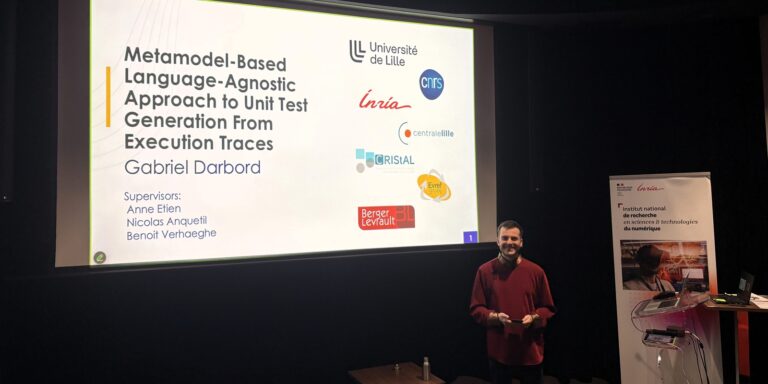Explore our projects & studies
Explore our projects & studies
From Artificial Intelligence to Human-Computer Interaction and Software Architecture, our research team tackles complex problems across many domains. We seek at providing the best of modern technology for public services, health-care and industry.

Usage discrepancies: when business software meets real life
Do users really follow the paths carefully mapped out by designers? And when reality goes beyond the scope of the design—which happens more often than we think—how can we know this other than through intuition and assumptions? On a daily basis, business-oriented software supports very concrete activities: managing leave, processing

Gabriel Darbord Ph.D. thesis defense: “Automatic test generation to help modernize our applications”
Friday 5th December at 9a.m. Paris time, Gabriel Darbord, Ph.D. Candidate has defended his thesis named “Automatic test generation to help modernize our applications”. His thesis defense took place in Lille, France. Take a look at the summary below. This thesis is fully in line with the partnership between Berger-Levrault

Enhancing Functional Testing Efficiency in Industrial Large-Scale Applications: Pertinent Test Selection
Introduction In modern software development, application reliability relies on effective testing strategies. Altough unit and integration tests secure internal consistency, functional testing remains essential for validating user-facing behaviors. For large-scale applications like Alpha Tool, running thousands of functional tests is challenging: it consumes vast resources, slows down delivery, and complicates

Investigating Hand-Bound Pads for AR Input Using Hand-Tracking Only
What is Augmented Reality, and how is it used for Augmented Maintenance? Augmented Reality (AR) has emerged as a powerful tool for enhancing human-computer interaction, allowing digital content to be seamlessly integrated into the physical world. Unlike traditional desktop or mobile interfaces, AR enables spatially situated interactions, where virtual content

Making Large Numbers Count: Cognitively Informed Alternatives to Log-Scale Bar Charts
From carbon emissions to national budgets, we’re frequently asked to interpret values that span from thousands to millions and billions. These wide ranges—what we call Orders of Magnitude Values (OMVs)—are cognitively demanding for the general public and hard to represent with common charts. So, how can we make sense of

Explanation of the Coruscant Mobile project
This research is the result of a collaboration between Ali Can Kocabiyikoglu, Pascal Zaragoza, and Vincent Laval, part of the AI Laboratory | BL Research Team. The Challenge of Modern Maintenance Support A maintenance technician faces an unfamiliar “Error 20” on a medical device. Their hands are busy with tools,

From law to customer in seconds: automating legal compliance
Adherence to legal mandates is crucial for businesses, as failure to comply can lead to substantial penalties. In an environment where legal documents are constantly evolving, companies increasingly rely on automated processes to streamline analysis and to ensure ongoing compliance. The full automation process typically involves: (1) extracting legal terms

Airflow: feedback on BL.Predict and Foundation use cases
Introduction In a context where the automation of data workflows has become a fundamental pillar of project reliability and scalability, Apache Airflow has established itself as an essential tool within the technical ecosystem of our BL Research team, dedicated to Research and Technological Innovation at Berger-Levrault. Whether orchestrating text document

Applying Agentic AI towards enabling computerized maintenance management systems
In the critical domain of Computerized Maintenance Management Systems (CMMS), solutions like CARL Source empower businesses to efficiently create, schedule, and manage maintenance tasks. These platforms are widely used to coordinate work orders for repairing industrial machinery across multiple factories worldwide. *Update: Coruscant is the name given internally to this

Enhancing Domain-Specific RAG Applications through Synthetic Fine-Tuning
Keywords: Synthetic Data, Retrieval-Augmented Generation (RAG), Small Language Models (7B LLM), Large Language Models (LLM like GPT-4o or GPT4.5), Model Adaptation, Efficient Model Tuning, Low-Resource Fine-Tuning, Synthetic Fine-Tuning. 1. Introduction In the context of our Research & Innovation efforts at Berger-Levrault, we are exploring how large language models (LLMs) can
